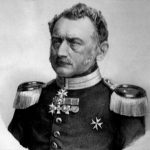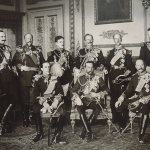This campaign was the advance of the Allies through France following the successful invasion of D-Day. It is important because it contains the blindest and most incomprehensible mistake made by a commander-in-chief in all History. But we will come to that later.
Combined with the Soviet invasion of Germany from the east, the campaign would lead to the end of the Second World War and the inevitable Treaties. Following the Normandy invasion most German armies were withdrawn from France, though not all. British and Commonwealth troops entered Brussels on 3 September, 1944, and Antwerp was relieved one day later. The port could not be used immediately because pockets of German resistance had been left behind in the mouth of the Scheldt, and had to be dealt with.
Field Marshal Bernard Montgomery (a fighting man) wanted all Allied troops except those in the South of France to be concentrated (under his command) for a major thrust across the Rhine north of the industrial Ruhr Valley. This could cut it off from the rest of Germany, meaning no armaments or munitions for German soldiers. Montgomery could then move on and take Berlin. The Allied Supreme Commander was ‘Ike’ Eisenhower (who had never fought a war anywhere) and he said no. British and American troops must stay, said Ike, to fight small German garrisons in French ports such as Calais. This meant that 75% of supplies had to come from the D-Day beaches in Normandy, and the rest from the Cherbourg peninsula, 300 miles away. The French railway system had been crippled (partly by French resistance workers) so supplies had to come by road.
Bernard Montgomery was told that his idea was negative. Ike wanted him to clear the left bank of the Rhine first, with an attack over a broad front. He was however in agreement with Montgomery over his ill-fated idea of seizing the bridges of the Rhine at Arnhem in Holland, using parachute regiments and gliders. Monty had been told that there were no significant German forces left in the Netherlands, and the idea seemed brilliant (q.v.). General Browning was put in charge of management and on 17 September British paratroops were dropped massively at Arnhem in advance of the main Allied thrust but met fierce opposition from no less than two Panzer divisions previously concealed by the enemy. Dutch and British intelligence had not noticed them.
Nine thousand paratroops had been dropped in the operation at Arnhem, and only a little more than two thousand managed to escape south. The rest were killed, badly wounded, or taken prisoner. It was a major disaster, and Montgomery and ‘Boy’ Browning were blamed.
In November six Allied armies attacked on a broad front but made little progress. Montgomery wrote in his Memoirs that they in fact attacked on several distinct fronts and were uncoordinated. This might have been sour grapes, but his growing dislike of the Dutch/American General Eisenhower was becoming apparent. He was not alone in his disapproval.
Surprising the Allied commanders, the German armies rallied and made a counter-attack in December, 1944, and managed to win some engagements with their enemy. The Battle of the Bulge defeated them however, and afterwards they were too weak effectively to resist the Allied Rhineland Campaign of February and March 1945. From Berlin Hitler ordered German troops to fight west of the Rhine instead of retiring over it. This brought another 250,000 prisoners for the Allies to imprison and feed. On 7 March the US troops found a bridge at Remagen that had been kept intact for retiring German armies. This bridge could be used by the Allies, and was placed near the important city of Bonn (where Beethoven was born).
The fighting American general Patton crossed the Rhine successfully on March 22 between Mainz and Worms (beautiful but badly damaged medieval cities) and advanced at his usual breakneck speed into Bavaria. Things were going better. Better still when Monty also crossed the Rhine on 23 March, believing that he and Patton would now do the logical thing and advance on Berlin, taking it before the Russians got there. But Eisenhower told him to march North/West to Hamburg and Lübeck. General Bradley (another fighting general) was to direct the main advance towards Leipzig and Dresden (which would later be in the East German/Russian Zone!) Ike directed that the Russians must be left to take and occupy Berlin. It was this quite extraordinarily bad decision which effectively allowed the Cold War to begin. The fighting generals were amazed, but supposed that Eisenhower must have some purely logical (or political) reason for his astounding decision. After all, he was Supreme Allied Commander.
Meanwhile the main drive east continued with little opposition: the Americans forged onwards and arrived at the Elbe on 13 April, only sixty miles from Berlin. And that is where they halted. On May 2 the British and Commonwealth armies reached the Baltic at Lübeck. German troops were flying from the Russians in order to surrender to British or American forces. As the Russians had burned, looted and raped their way through North and North-East Germany, it was not surprising.
German forces in North-West Europe surrendered (to Field-Marshal Montgomery) at Lüneberg Heath on May 4, and three days later there was a general German surrender much to the fury of Hitler, who was left to commit suicide in Berlin while Russian soldiers sacked what was left of this fine German city. In the awful conferences at Yalta etc. that followed, an exuberant Stalin was able to grab everything he wanted. Roosevelt was dying; Churchill was exhausted, both were powerless to complain. The Cold War did not take very long to start.
(We welcome Comments on this post and every other on this website)











Leave A Comment